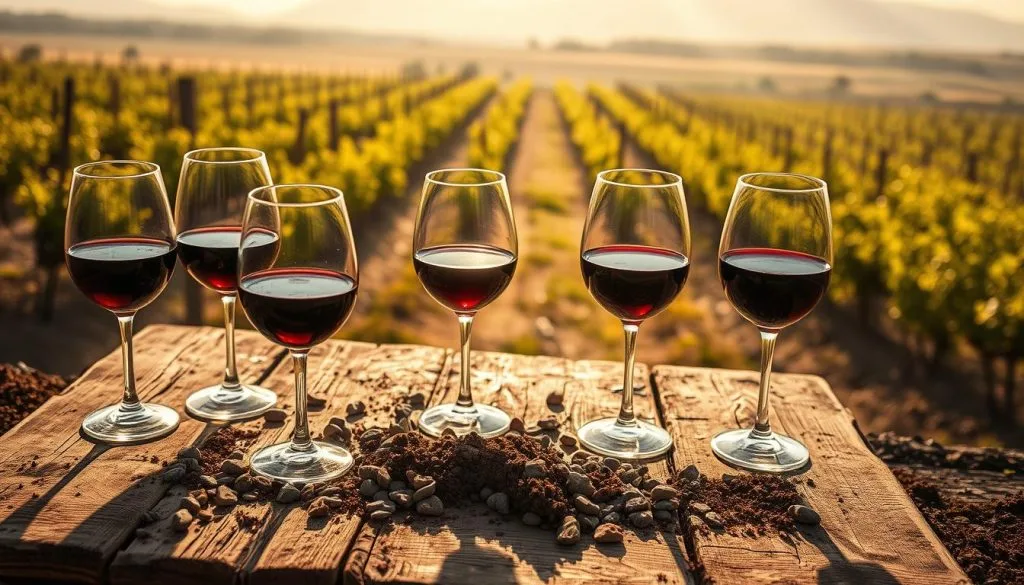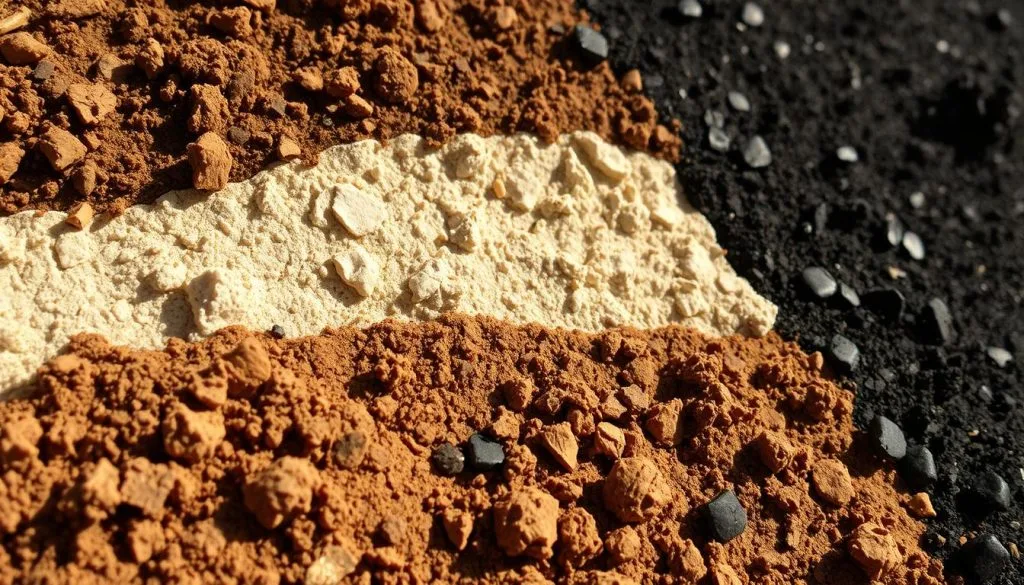This post may contains affiliate links. Read our full disclosure here.
What if the secret to that $100 Cabernet isn’t just the winemaker’s magic—but what’s under their boots? From Bordeaux’s regal estates to California’s sun-drenched valleys, the ground beneath vineyards acts like a backstage crew for your favorite bottle. This isn’t just dirt—it’s a living, breathing ecosystem that shapes every sip.
Think of clay as the overachiever: it holds water like a camel’s hump, forcing vines to dig deep for nutrients. Sand? It’s the chill friend who drains fast, creating elegant wines with laser-focused aromas. Then there’s limestone—the diva of the trio—imparting crisp acidity that makes Champagne sparkle and Chardonnay sing.
Take Château Charmail in Bordeaux, where clay-limestone blends craft structured reds that age like fine leather jackets. Or Russian River Valley’s Zinfandel vines, thriving in sandy soils that stress plants just enough to concentrate flavors. These aren’t accidents—they’re geological love stories written over millennia.
Here’s the kicker: dirt is dead. Soil? It’s got more drama than a reality show—25% air pockets, 45% mineral particles, and a 5% organic matter cocktail that feeds roots. Get this relationship right, and you’re not just growing grapes—you’re curating liquid art.
Exploring the Role of Soil in Wine Terroir
Why do some vineyards produce liquid gold while others struggle? The answer lies beneath the surface—where living earth collides with geology’s ancient blueprints. This isn’t just farming; it’s a high-stakes tango between roots and rocks.
Soil vs Dirt: A Foundational Comparison
Dirt is what you scrub off jeans after gardening. Soil? That’s nature’s VIP lounge—teeming with fungi, bacteria, and nutrients that vines crave. When displaced, soil becomes dirt—like turning a rainforest into sawdust. As one geologist quipped: “Dirt’s where life ends. Soil’s where it begins.”
Take Burgundy’s legendary slopes. Their marly limestone-clay mix acts like a geological fingerprint, giving Chardonnay its razor-sharp acidity. Meanwhile, Germany’s Mosel Valley thrives on heat-retaining slate—Riesling vines clinging to slopes like rock climbers.
Influence of Parent Rocks on Soil Formation
Granite weathers into gritty sand, forcing vines to dig deep. Volcanic soils? They’re the espresso shot of terroir—packed with minerals that scream through Syrah’s peppery finish. Limestone breaks down into alkaline earth, balancing pH levels like a master sommelier.
In Napa’s Stags Leap District, volcanic ash meets ancient sea beds. Cabernet grapes here develop silky tannins you’d mistake for cashmere. It’s proof that parent rocks don’t just feed vines—they write flavor novels in every bottle.
Understanding Soil Types in Viticulture: Unlocking the Secrets
Ever wonder why certain wines taste like liquid geography? Four underground architects shape every bottle’s personality:

Key Soil Compositions and Their Characteristics
Sandy soils play hard to get—draining water like colanders. This stress creates Zinfandels in Lodi with jammy intensity. Their heat retention? A lifesaver in cool climates, producing aromatic whites that smell like summer in a glass.
Clay is the overprotective parent. Rioja’s Tempranillo vines thrive in its moisture-rich embrace, crafting wines with leathery depth. But add gravel—like Bordeaux’s Left Bank—and you get Cabernets with structure tighter than a drumline.
Oregon’s Willakenzie silt makes Pinot Noir sing. These fine particles retain just enough water for velvety textures, while forcing roots to hustle for nutrients. Result? Wines with more layers than a prestige TV drama.
Loam is the Goldilocks blend—sand, silt, and clay in perfect harmony. Napa’s rock-star vineyards use it to balance vigor and restraint. But beware: too fertile, and vines get lazy. Prune aggressively, and you’ll harvest grapes worthy of their $200 price tags.
Rocks aren’t just scenery—they’re flavor conductors. Mosel’s slate acts like solar panels, baking Rieslings with electric acidity. Volcanic soils in Sicily inject minerals so sharp, they’ll make your taste buds sit up straighter than a posture coach.
How Soil Compositions Shape Wine Quality and Regional Character
Ever tasted a wine that screams its birthplace? The ground beneath vineyards acts like a flavor DJ—mixing mineral basslines with climate-driven beats. From schist’s electric energy to loam’s balanced rhythm, earth’s layers craft liquid identities as distinct as zip codes.

The Impact of Sandy, Clay, and Silt Soils on Vineyards
Sandy soils in Loire Valley work like nature’s colander. Fast drainage stresses vines, squeezing out aromatic whites with laser-focused citrus notes. Meanwhile, Bordeaux’s clay grips water like a security blanket, pumping Merlot with plush tannins that taste like velvet handshakes.
Silt in Oregon’s Willamette Valley plays both sides. Its fine particles trap just enough moisture for Pinot Noir’s silky textures while forcing roots to hustle—creating wines with more depth than a philosophy podcast.
Role of Loam and Calcareous Soils in Viticulture
Loam is the Tinder algorithm of dirt—matching sand, silt, and clay in perfect ratios. Napa’s rock stars use it to balance vine vigor and restraint. “Too fertile, and grapes get lazy,” says a vineyard manager. Calcareous soils? They’re the mineral hype crew, injecting Chablis Chardonnay with acidity sharper than a TikTok clapback.
Rocks, Minerals, and Their Effects on Drainage and Temperature
Schist in Spain’s Priorat acts like nature’s battery pack—storing heat by day, releasing it at night. Slate in Mosel Valley turns steep slopes into solar panels, baking Riesling with electric zing. These aren’t just rocks—they’re flavor conductors rewriting regional playbooks.
Granite in Beaujolais proves roots love a challenge. Its gritty texture forces vines to dig deep, unearthing minerals that make Gamay taste like crushed gemstones. As climate shifts accelerate, smart soil management isn’t just farming—it’s future-proofing liquid art.
Conclusion
Your next glass of wine isn’t just fermented grapes—it’s a geological mixtape. From Napa Valley’s heat-retaining volcanic soils to Loire Valley’s chalky slopes that drain like Olympic sprinters, every texture tells a story. Silt soils in Oregon craft velvet-textured Pinots, while quartz-rich gravels in Bordeaux give Cabernet its backbone.
Water retention isn’t just agronomy—it’s liquid architecture. Clay holds moisture like a suspenseful pause, while sandy earth lets it slip away like a plot twist. The Loire’s crisp Sancerre? Thank its limestone for good drainage and mineral kick. Napa’s opulent Cabs? Volcanic earth that retains heat like a nightclub crowd.
Dirt is debris. Soil? A living archive where parent rocks whisper to roots through minerals and pH levels. Master this dialogue, and you’re not just drinking wine—you’re decoding terroir’s DNA.
So next time you swirl a glass, remember: every speck of quartz writes a sentence in your bottle’s story. Because great wine isn’t made—it’s unearthed.




